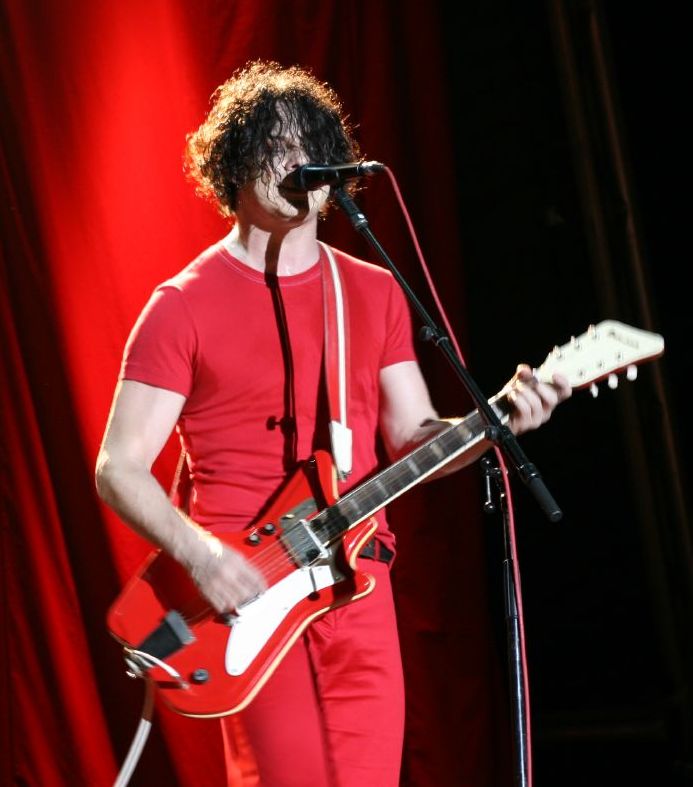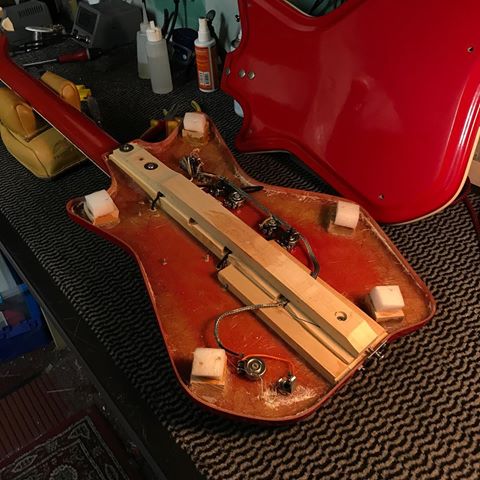
Airline guitars have come a long way since their late-Fifties early days. But, how do the new ones, made by Eastwood Guitars, compare to the originals? Res-O-Glass vs. Mahogany, Old vs. New. Who wins?
The original Airline guitars were cheap, plastic (or rather, “Res-O-Glass”) models made between 1958-1968 and sold by Montgomery Ward via shops and catalogues. They were never intended to be great-quality instruments – but cheap alternatives for beginners who couldn’t afford bigger brands such as Fender, Gibson or Gretsch.
Most Airlines were made of Res-O-Glass simply because it made them cheaper and quicker to be put together – with no particular regard for quality or tone.
However, this characteristic made those guitars quite unique, and eventually a few professional players started to appreciate the qualities of the Res-O-Glass tone as “a thing”.
One of the first performers to be closely linked to the instrument was bluesman J. B. Hutto, whose red Airline must’ve been one of the inspirations for Jack White playing one, decades later:
Ah yes… Jack White. Despite the fact other musicians over the years have opted for vintage Airline Guitars (PJ Harvey, Calexico, Black Keys, Brian Jonestown Massacre) it was Jack White who most certainly brought the brand (especially the now-iconic JB-Hutto guitar shape) to the attention of a wider audience.

Jack White live with his Airline Guitar, in The White Stripes
Vintage Airline Guitars vs. Eastwood Airline Guitars: What’s the Difference?
When considering which one to buy, it’s important to remember a few things.
1) The first is this: Jack White didn’t really like his Airline guitar.
Yes. True. He, basically, thought they were terrible. Not long ago, White described his experience playing them:
“If people only knew how hard it was on these shitty guitars … because I didn’t know!”

New Airline guitar headstock – it is what it says it is… an Airline!

The inside of a vintage Airline guitar… not a pretty sight!

Airline 59 2P – the current version of the classic Airline model, by Eastwood
But, of course, there are other, less obvious but very important changes – or, as should we call them, upgrades: the tone-chambered mahogany body, Airline vintage voiced Single coils (Humbucker-sized), tune-o-matic bridge and bolt-on maple neck. The new Airlines sound great, rich, and are more comfortable and familiar to play than vintage ones.
The vintage Airline Res-O-Glass guitars are undoubtedly cool, and any guitarist will get extra kudos for owning one. If you got one dirty cheap in the 90’s, that would’ve been definitely 100% worth it, even if no one wanted to buy one anymore, today. But now… are they really worth the price tag they go for today, after the Jack White hype? Mmmm…
So, the big question, then: are the new Airline guitars by Eastwood better than the originals? We would say so – just as many professional musicians playing one, worldwide also would. Let’s face it, a tone-chambered mahogany body beats plastic any day. There’s a reason why most guitars by most brands are made of wood, after all.
But we’ll leave the final answer to you – after all, in everything in life, and certainly when it comes to guitars, your own taste is what matters, and it’ll change from player to player. If you ever come across a Res-O-Glass guitar, by all means have a go – you might even love it. But will it be worth the investment, especially if you’re a gigging musician? Perhaps… perhaps not.
Watch: Vintage Airline Guitar vs. New Airline Guitar by Eastwood
Vintage Airline guitar demo:
New Airline guitar demo:


For me its a question of identity. For example, Fender release jazzmasters and Stratocasters with two humbuckers and name them by virtue of their body shape. I’m sure they are perfectly good guitars, but they are not a jazzmaster or a strat because they don’t sound like a jazz or a strat. The humbuckers changes their sound fundamentally. Likewise, did the original Airlines have a distinct sound, and if so, do the new Airlines have that sound, regardless of their superior build quality and even positive sound qualities. If it doesn’t sound like an original Airline, well then you have a different guitar, regardless of the shape and copyright authenticities. Guitars have been cherished for their individual signature sounds, and they tend to be the one’s that endure.
I’m an old guy who played some of those plastic guitars. They were awful! Airline as brand was right up there with Edsel and Rambler. In the 1960’s Japan destroyed the American guitar industry by dumping knockoff and original guitars at super cheap prices. I am amazed at what a vintage Epiphone Wilshire, Coronet etc. sales for they were crap. I had a ’67 Mustang, total neck diver, ridiculously narrow neck, I’d loan it my friends in need of guitar in a pinch and after the gig they’d threaten to kick my ass. Now is the greatest time in history to buy guitars..truly a golden age…buy new. I own two Eastwoods, I wish they were lighter weight, but other than that they are good guitars at really reasonable prices.
I do not know, I was not there, but I have read in the guitar geek press that Res-O-Glass turned out to be much more expensive to manufacture than anticipated and, as such, did not do so well for Valco, and also that the National Map guitars and such were pretty pricey in their day. Your assertion that Eastwood Airlines are real Airlines because Mike, who I believe to be a good guy, bought the name raises an interesting question: since major manufacturers like Gibson and Fender have undergone repeated changes of ownership, key personnel, manufacturing facilities, and specs, who really has the right to claim the name, the owner of such, or rather the entity that builds the best or more authentic version of a particular model? Beats the heck out of me. Reminds me of the arguments I had with my father during the horrible era of digitally colorizing old B&W movies. I maintained that one should not mess with someone else’s art, whilst Dad felt that they bought it, they own it, they can do what they want with it.
IN my opinion the vintage airline had better tone than the new one. Maybe it’s because the pickups have aged or something. Thanks
There’s always the DIY/kit option (note: I’m not in any way connected with these folks):
http://www.guitarkitsusa.com/
Just make the guitar with the fiberglass body exactly like it used to be made. It cannot possibly be that hard to make this guitar the right way. It’s so dumb. It’s just a typical case of North Americans wanting to make money but not wanting to do the work. Having said that, I’m sure you could find a slave labor factory in Korea or China somewhere to make it out of fiberglass for you.
Why not strike a deal with Guitar Kits USA to make a run of Res-O-Glass instruments? My opinion is that your wood instruments may sound “superior” but they do not sound unique. They sound like Les Paul knockoffs shaped like Airline guitars, which is basically what they are since they are mahogany with humbuckers. These old cheap department store guitars have a certain edge and “hollowness” to them that makes them sonically appealing. That adds up to a lot more than just looks. What sucks is that the vintage units just aren’t worth the high prices based on materials alone. Hey, if Danelectros can be manufactured in the present day with Masonite, why not these with Res-O-Glass?
I’ve played a new Supro and own a 1964 resoglas… it’s not even close. The vintage feels much better. The neck is set differently and plays beautifully. The new ones feel… new. Doesn’t feel much different than playing a PRS.
wow !! nice article
thank you for sharing this information, this is very helpful for a guitarist.
I also have a guitar blog guitartronic.com that helps to people those who want to know about latest guitar trends, guitar reviews and many more latest updates.
visit :- https://www.guitartronic.com
Nice article,
Thank you for sharing
I think the new ones sound better. By a mile. I get that the sound of the originals was part of the White Stripes thing, but a massive amount of gain had to be used to pull that off. I’d rather have a guitar that’s way more responsive so I can get better note/string definition out of it. The necks are way better on the Eastwoods too (like their newer generation Mostrite model types). Now you might think that’s negligible. But I have huge hands. I need well thought out neck designs if I’m going to get around on a guitar. But what do I know, I’m just an audio engineer who was trained by a world class top 40 mix engineer. No big whoop. It’s not like critically listening to everything in the minutia is my dang job or anything. =P
really the article is helpful to know about guitars first time. I appreciate that. And thanks. and please keep me informed more as u get.
I have never played a vintage Airline, but I have an airline h77, a new one, and I think it’s one of the most wonderful guitars I’ve ever played.
Trends Follow I just want you to know that I’m deeply grateful for your amazing post! Thanks for the kindness in sharing your expertise to us.
Khalyla Kuhn
Joey Diaz
For me it’s a question of tone: the old Airline had a characteristic tone despite its crappy and inconsistent construction and performance. While the new Airlinesnhave solved the structural and (possibly) electronic issues it seems entirely unlikely that they have *that tone.*
Can someone address this? What do the new ones sound like? Would J. B. Hutto be satisfied? Do the new ones have that “growl” and aggressive attitude? I’d love to know.
When I was 11 years old in 1962, my Dad bought me a airline red 2pu 59 at Montgomery Wards mine was a wood body it met its end around 1975. My 3 year old son accidentally knocked it over on concrete and broke the neck off. Back then my cousin and I teamed up and we won alot of talent contests with that airline I played lead and my cousin had a 1 pu Harmony electric guitar we both had harmony amps. Had a lot of fun. Dad paid $99.00 for that airline.
Nice post. I was checking continuously this weblog and I am impressed!
Very helpful info specially the last phase: I handle such info a lot. I used to be looking for this
particular info for a very long time. Thanks and best of luck.